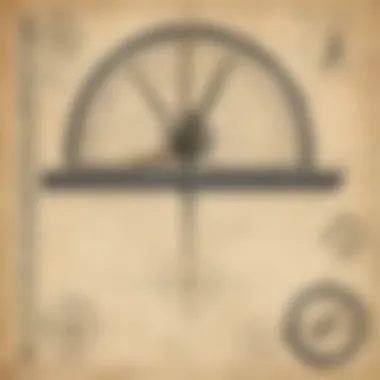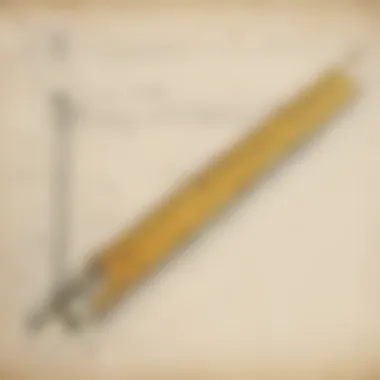Mastering Angle Measurements: A Kid-Friendly Guide


Intro
Understanding angles is a foundational aspect of geometry. Angles help us describe shapes, movements, and even navigation. For young learners, grasping the concept of angles can be a journey filled with discovery and creativity. This guide aims to break down the measurement of angles into digestible parts, making it accessible for elementary school children. By focusing on definitions, measurement tools, and common techniques, we create a framework for exploring angles both theoretically and practically.
Creative Activities
Engaging activities can enhance the understanding of angles. Here, we introduce various craft ideas that are both fun and educational, allowing children to learn by creating.
Craft Ideas
- Angle Art: Using colorful paper, kids can create designs that incorporate different angles. They can cut out various shapes and discuss the angles as they work.
- Protractor Pals: Make protractors using cardboard. Children can practice measuring angles in a hands-on way.
- Angle Hunt: Take children on a scavenger hunt to find real-life angles around the house or classroom. They can take pictures and measure these angles later.
Step-by-Step Guides
Angle Art Instructions:
- Gather colored paper, scissors, and markers.
- Cut out various shapes like triangles, squares, and rectangles.
- Discuss the angles in each shape.
- Use markers to label the angles with their degree measurements.
Protractor Pals Instructions:
- Cut a semicircle from cardboard.
- Mark angles in increments of 10 degrees.
- Use this homemade protractor to measure angles in your Angle Hunt.
Educational Value
These activities promote critical thinking and creativity. As children engage in hands-on learning, they develop a better understanding of how angles exist in both art and the environment.
Fun Quizzes
Quizzes are a fantastic way to reinforce learning. They can be tailored to cover various topics related to angles.
Quiz Topics
- Identifying angles: acute, obtuse, and right.
- Measuring angles using a protractor.
- Real-world applications of angles.
Question Types
- Multiple-choice questions to identify angle types.
- Fill-in-the-blank for defining terms.
- True or false to assess comprehension of angle properties.
Knowledge Reinforcement
Quizzes provide immediate feedback. They help children realize areas needing improvement while encouraging further exploration of the subject.
Fact-Based Articles
Articles can be a rich resource, offering insightful information on angles and related topics.
Topics
- The historical significance of angles in architecture.
- The role angles play in everyday life, like in sports and art.
Engaging Content
Content is structured to be reader-friendly, making complex ideas simple to understand. Illustrated examples can enhance comprehension, ensuring that learning remains engaging.
Understanding Angles
Understanding angles is central to the study of geometry. Angles are everywhere, from simple shapes to complex structures. They help us navigate the world, create designs, and solve practical problems. This article aims to effectively explain angles, making it simple for young learners to grasp the concept fully.
What is an Angle?
An angle is a figure formed by two rays, called the sides of the angle, that share a common endpoint, known as the vertex. Angles are measured in degrees. Degrees indicate how open or closed an angle is. The smaller the angle, the tighter the opening between the rays.


Learning about angles lays a foundational understanding of geometry. Recognizing angles helps in various fields. Architects design buildings, artists create visually appealing compositions, and engineers construct machines—all requiring good knowledge of angles. Understanding angles opens up pathways to many practical applications.
Types of Angles
Angles come in several distinctive types, each with unique properties. Here, we will explore five primary types of angles:
Acute Angles
Acute angles measure less than 90 degrees. Their key characteristic is that they are sharp and pointy. This type of angle is a popular choice in various areas, such as art or design, where sharp lines create dynamic visuals. A notable unique feature of acute angles is their capability to fit into tighter spaces. This is advantageous, especially in design work, where precision matters. However, being too sharp can lead to instability in some physical structures.
Right Angles
Right angles measure exactly 90 degrees. This angle is often referred to as the gold standard in constructions, as it forms the basis of square structures and precise right turns. Its key characteristic is that it seems perfectly balanced, making it a favorite in design and building. A unique feature of right angles is their ability to establish uniformity in shapes. One possible disadvantage is that too many right angles in design can create a boring and predictable look.
Obtuse Angles
Obtuse angles measure more than 90 degrees but less than 180 degrees. These angles appear more relaxed and wider than acute angles. A significant aspect of obtuse angles is their ability to create spaciousness in designs. Though they provide versatility, obtuse angles can be less suitable for cramped spaces. Their unique feature lies in their use in natural forms, as seen in specific plant or animal shapes. One disadvantage is that they can complicate construction and architecture if used excessively in structural designs.
Straight Angles
Straight angles measure exactly 180 degrees. They create a straight line, showcasing uniformity and smoothness. The crucial characteristic of straight angles is their ability to divide planes into two equal halves. This property makes straight angles useful in geometry and construction. A notable feature is their structural simplicity. However, their limitation is that they do not add dimensionality or interest in designs, which could lead to monotonous appearances.
Reflex Angles
Reflex angles are those that measure more than 180 degrees but less than 360 degrees. They are less common but vital in specific applications. Their key characteristic is a large opening, which allows for unique designs. Reflex angles can add visual intrigue and are often used in creating complex shapes. However, their unique feature can present challenges, as they may lead to instability in physical structures if not balanced correctly.
Real-Life Examples of Angles
Angles appear regularly in our daily lives. From the simple corners of a table to the complex designs of buildings, angles contribute to the world around us. Recognizing these real-life examples can enhance understanding. Schools, tools, and even nature exhibit different angles. Exploring these instances can make learning about angles engaging and relatable for young audiences.
Tools for Measuring Angles
Understanding the tools available for measuring angles is crucial in mastering geometry. These tools not only help determine angles accurately but are also essential in various practical applications. For young learners, knowing how to use these tools can foster a keen interest in mathematics and problem-solving. In this section, we will explore three primary tools: the protractor, ruler, and digital applications. Each tool has its own strengths and considerations, making them valuable for different scenarios.
Protractor: The Essential Tool
The protractor is perhaps the most recognized instrument for measuring angles. It is a semi-circular device marked with degrees from 0 to 180, specifically designed to aid users in determining the measure of an angle.
Using a protractor is simple. Here are the steps:
- Position the Protractor: Place the midpoint of the protractor at the angle's vertex.
- Align the Baseline: Make sure one side of the angle aligns with the baseline of the protractor.
- Read the Measurement: Follow the scale on the protractor to find the angle’s measurement.
Ensure you hold the protractor steady and check if you are reading the inner or outer scale correctly. This common mistake can lead to incorrect measurements. Therefore, knowing how to read a protractor accurately is essential for elementary school children. Practice is key, as becoming adept with this tool can enhance confidence in geometry.
Using a Ruler
A ruler, primarily known for measuring lengths, can also be a valuable tool in determining angles when combined with other tools. While it will not provide an exact angle measurement by itself, it can be used to draw lines that form angles, facilitating angle creation and understanding.
For example, if students want to construct a triangle, they can use a ruler to:
- Draw one side of the triangle.
- Measure and mark points for the other two sides.
- Carefully connect those points, forming angles.
Using a ruler helps students understand the relationship between line lengths and angles. Also, when students draw angles or shapes accurately, they gain a practical appreciation of geometry.
Digital Tools and Apps
In today’s digital age, many applications and online tools are designed to measure angles and enhance understanding of geometry. These technological solutions provide users with interactive and engaging ways to learn. Some popular tools include:
- Geogebra: An interactive geometry software that helps visualize different angles and geometric shapes.
- Angle Meter: An app available for smartphones that allows users to measure angles directly using the device’s camera.
These digital tools are helpful for visual learners, as they often include tutorials and exercises to reinforce understanding. They make learning fun and accessible, which is crucial for young learners. However, it’s essential to supplement these tools with traditional methods to ensure comprehensive knowledge.


Remember: Each tool has its purpose. Practicing with them can lead to a better understanding of angles and geometry's practical applications.
Familiarizing oneself with these measuring tools will prove beneficial not just in classroom settings but also in real-life scenarios. By mastering the use of a protractor, ruler, and digital applications, learners will lay a solid foundation in geometry, allowing for greater success in future mathematical endeavors.
Measuring Angles with a Protractor
Measuring angles is a crucial aspect of geometry that provides insight into various shapes and objects. The protractor is one of the most accessible tools used for this purpose. Understanding how to measure angles with a protractor offers both practical benefits and theoretical knowledge. Using this tool can help young learners visualize and appreciate angles in their environment. Additionally, it supports foundational skills in mathematics and geometry that are essential for future academic pursuits.
Step-by-Step Instructions
Measuring angles with a protractor is straightforward. Here are detailed steps to follow:
- Gather Your Materials: You will need a protractor, a ruler, and a pencil.
- Draw an Angle: If you don't have an angle to measure, use the ruler to draw one on paper. Label the vertex where the two lines meet.
- Position the Protractor: Place the protractor's midpoint (the small hole) over the vertex of the angle.
- Align the Base: Ensure that one side of the angle aligns with the zero line of the protractor. This may require some adjustment.
- Read the Measurement: Look at where the other side of the angle crosses the number scale on the protractor. You might have a choice between degrees on the inside or outside scale—be sure to select the correct one. The value you identify is the measure of the angle.
- Record the Measurement: Write down the angle measurement, ensuring you use the correct symbol (°) to indicate degrees.
Following these steps allows anyone to accurately measure angles, enhancing their understanding of geometric concepts.
Common Mistakes to Avoid
While measuring angles with a protractor seems simple, there are common pitfalls. Being aware of these can help ensure accuracy:
- Misalignment: It is easy to misalign the protractor. Always check your alignment before recording any measurements.
- Reading the Wrong Scale: Double-check which scale you are using. Measurements can differ between the inner and outer arcs on the protractor.
- Ignoring the Vertex: Ensure that the midpoint of the protractor is correctly positioned at the angle's vertex. Incorrect placement can lead to inaccurate results.
- Rushing the Process: Take your time. A rushed measurement often leads to mistakes. If unsure, double-check your work.
Awareness of these common mistakes can improve accuracy in measuring angles, making learning geometry more effective.
Tip: Practice measuring different angles to build confidence and improve your skills with the protractor.
Other Methods for Finding Angle Measurements
Understanding other methods for finding angle measurements is crucial for grasping the vast field of geometry. Different contexts require various techniques, and knowing them provides more flexibility in solving problems. These methods can simplify complex scenarios and allow for unique insights into angle relationships.
Using Geometry Formulas
When it comes to angles, geometry formulas can serve as valuable tools. These formulas help simplify calculations and relationships involving angles in different types of shapes, especially triangles.
Angle Relationships in Triangles
Angle relationships in triangles provide a basis for many geometric principles. In any triangle, the sum of the angles always equals 180 degrees. This key characteristic is fundamental and makes it a popular choice for teaching angle concepts.
Using these relationships, one can find the unknown angles if at least one angle is known. For example, if a triangle has two angles measuring 50 degrees and 70 degrees, the third angle can be found by simply subtracting the sum of the known angles from 180 degrees:
This formula is effective due to its straightforward nature. However, it may not work as well in more complex polygons.
Complementary and Supplementary Angles
Complementary and supplementary angles serve as foundational concepts in measuring angles. Complementary angles add up to 90 degrees, while supplementary angles add up to 180 degrees. This feature makes them beneficial for various practical scenarios where angles often interact.
For instance, in constructing right angles, knowing complementary angles is key. If one angle is 30 degrees, its complement will be 60 degrees. In terms of application, this can help with design projects or building tasks where angles need to fit together accurately.
However, one disadvantage is that they only apply to pairs of angles, which may limit their usefulness in more complex configurations where multiple angles are interconnected.
Constructing Angles
Constructing angles involves creating angles with specific measurements, which is not only helpful in practical applications but also reinforces understanding. Using a compass and a ruler can allow one to construct angles accurately. This skill is particularly useful when precise measurements are necessary.
In classrooms, students often practice constructing angles to reinforce their understanding of measurement. Learning how to make specific angles can enhance spatial reasoning and demonstrate real-world applications, such as in architecture or computer graphics.
Overall, exploring these methods promotes a broader understanding of angle measurement beyond tools and techniques. Each method offers unique advantages and potential limitations, making them essential in angle-related tasks.
Practical Applications of Angles


Understanding angles goes beyond textbooks and classrooms. It is essential for our daily lives and various fields such as architecture, engineering, and art. Knowing how to measure and apply angles can help people in making informed decisions in different areas.
Angles in Everyday Life
Angles matter in many routine tasks. From using a ruler to draw straight lines to arranging furniture in a room, angles play a crucial role. For example:
- Sports: In sports like basketball, the angle of the shot can determine success. Players must calculate the best angle to shoot the ball for a higher chance of scoring.
- Construction: Builders use angles for walls and roofs. Correct angle measurement ensures the stability and longevity of structures.
- Navigation: Angles help in determining directions. For instance, when using a map or GPS device, understanding angles allows you to navigate accurately.
In these examples, recognizing angles enhances efficiency and helps in achieving desired results.
Angles in Art and Design
Angles are also significant in the creative world. Artists and designers rely on angles to craft visually appealing works. Here are some examples:
- Architecture: Angles in buildings can create unique shapes and forms that attract attention. Designers consider angles to optimize light entry and space use.
- Graphic Design: In graphic design, angles contribute to layouts and composition. Proper angle use can guide the viewer’s eye and enhance the overall appeal of the design.
- Painting: Artists often use angles to create depth and perspective. They manipulate angles to make their work realistic or to convey emotions.
Understanding angles allows artists and designers to work effectively and communicate ideas through their creations.
In summary, knowing angles helps individuals apply artful techniques and practical solutions in everyday life, enhancing various aspects of our experiences.
Activities and Exercises
In the study of angles, including measurement techniques, practical activities play a crucial role. Engaging students with hands-on exercises builds a deeper understanding of geometric concepts. When kids participate in these activities, they become active learners.
Young students can benefit immensely from relatable tasks. By relating angles to their real-life experiences, they can grasp the importance of measurements. This not only enhances their skills but also nurtures curiosity and critical thinking.
Furthermore, engaging in tasks related to angle measurement can make learning enjoyable. Simple games or DIY projects can reinforce concepts. Here are two exciting ways to explore angles together:
Angle Measurement Games
Games that involve measuring angles can be both fun and educational. One popular option is the Angle Hunt. In this game, participants search for various angles in their environment, whether indoors or outdoors. Each discovered angle should be identified and measured using a protractor.
The benefits of angle measurement games include:
- Encouragement of Teamwork: Children work in groups, developing social skills.
- Increased Engagement: Fun activities help maintain interest.
- Practical Application: Learners can see how angles function in real life.
Another game idea is Angle Bingo. Make Bingo cards featuring different angle measurements, such as 30°, 45°, and 90°. As you call out the angles, participants mark their cards. The first to complete a row wins. This game reinforces angle recognition and measurement skills while fostering a competitive spirit.
DIY Protractor Projects
Creating a DIY protractor can be a rewarding project for children. It encourages them to understand measuring tools while allowing creativity. Here’s a simple step-by-step guide:
- Materials Needed: Paper, ruler, pencil, and scissors.
- Draw a Circle: Use a plate or cup to trace a perfect circle on paper.
- Mark the Center: Find and clearly mark the center of the circle.
- Create the Line: Draw a line from the center to the edge of the circle, dividing it into two halves.
- Measure Angles: Use the ruler to mark equal divisions along the edge of the circle. Label them with angle degrees.
This DIY project not only teaches how to measure angles but also instills a sense of accomplishment in students.
Encouraging children to explore angles through creative methods is vital for their learning. Through games and DIY projects, they can build a robust foundation in mathematical concepts while enjoying the process.
Finale
Understanding the measurement of angles is a crucial part of geometry. In this article, we covered various aspects of angles, including their definitions, types, and methods of measurement. This knowledge is not just theory; it has practical implications in everyday life and various professions.
Knowing how to measure angles accurately allows individuals to engage in diverse activities, from simple crafts to complex engineering tasks. The tools mentioned, such as protractors and rulers, are fundamental for hands-on practices in classrooms and at home.
"Measuring angles correctly is foundational to developing skills in geometry and beyond."
The benefits of grasping this topic extend beyond academics. Children can learn to recognize angles in their surroundings, fostering spatial awareness and critical thinking. The different activities suggested encourage playful exploration, making learning enjoyable.
Recap of Key Points
- What is an Angle?: An angle is formed by two rays with a common endpoint.
- Types of Angles: We explored acute, right, obtuse, straight, and reflex angles.
- Measurement Tools: Protractors, rulers, and digital apps can all assist in measuring angles.
- Measuring Techniques: Step-by-step guidance was provided for using protractors effectively.
- Practical Applications: Angles are present in art, design, and everyday life, showcasing their relevance.
- Engaging Activities: Games and DIY projects encourage hands-on learning.
This recap serves as a reminder of the key concepts covered, reinforcing the importance of angle measurement.
Encouragement for Exploration
I encourage both young learners and their caregivers to explore the world of angles further. Mathematics, especially geometry, is often seen as a challenging subject, but with the right tools and playful approaches, it can become an exciting adventure.
Consider engaging in real-world projects, such as measuring angles in art creations or even in nature. Encouraging curiosity and exploration allows children to appreciate the beauty of geometry and its applications.







